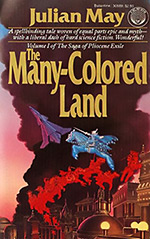
![]() bazhsw
bazhsw
4/11/2023
![]()
****MINOR SPOILERS IN REVIEW****
This was a really pleasant surprise. It's a book I didn't have high hopes for but in the end I really enjoyed.
'The Many-Colored Land' is set in the future where humans have colonised space and have relations with other intelligent alien life. Back on Earth, a scientist effectively invents one way time travel where people and objects can be sent back to the Pliocene era (2-5 million years ago) in the exact spot. What starts as a fancy for artists and other dreamers to go back in time soon becomes an industry as all kinds of people who want to escape their life in society volunteer to go back with no idea what they will face. Over time, tens of thousands go back so there is an assumption there is some kind of society but no one knows what. It turns out when the people go back, that humans are not the only intelligent life on Earth...
What we end up with is a brilliant blend of science fiction and fantasy set on a much younger Earth. May throws a lot of ideas at the book and they pretty much all land, so we do get quite a gonzo and pulpy novel (mind control, outdoor exploration, spacecrafts and riding prehistoric animals anyone). The difference is that this book plays it straight and is better for it. The very basic premise is humans are enslaved by an alien species called Tanu (with degrees of 'enslavement' and satisfaction amongst humans at the relationship). The Tanu have a relationship to another alien species called the Firvulag who they are in conflict with (one in seven Tanu births are a Firvulag). A small party of humans we are introduced to early in the novel manage to escape and change the dynamics on this Earth.
The pacing is good, once we get a slowish start introducing each individual character, the book rattles through the story and rarely lags. As a plot it is consistently engaging without one needing to think too much about it. I did appreciate the level of detail and research May must have undertaken for the novel, you can tell she loved doing it and how 'scientific' explanations are created for various events. All the characters are suitably different, although not to deep. I didn't care to much for them, but I didn't dislike them either, and none annoyed me. Certain things like characters falling in love quickly were a bit 'meh' but the characters are there to drive the story.
I did adore the nod to folklore and mythology and thought it was delightful that we have a possible source for much of European folklore in the book. I found it especially wonderful thinking both the humans and the alien species must die out, but the oral tradition of these people creates our folklore. If we except the premise of the story, then our elves and fairies are very old indeed!
My main criticism of the book is that as you near the end you think, 'this is book 1 of 2' (there ended up being nine books written in the setting). As a consequence of this I felt a little unfulfilled, there are a whole bunch of characters who are introduced at the start, have their own arc and then get dropped in the middle of book two. The end doesn't really feel like the end of the novel.
That criticism aside, I've probably read 'book 1' of lots of series and never picked up the next. If I get the opportunity I think I'd enjoy reading more of the series.
A final note, seeing as I am reading this as part of a speculative fiction LGBTQIA+ challenge. There are a couple of lesbian characters in the book but little is explored in terms of queer themes so I think this can be tagged under 'queer representation'.
Nothing to deep in this one, but a lot of fun with a clever world and story which I enjoyed a lot.